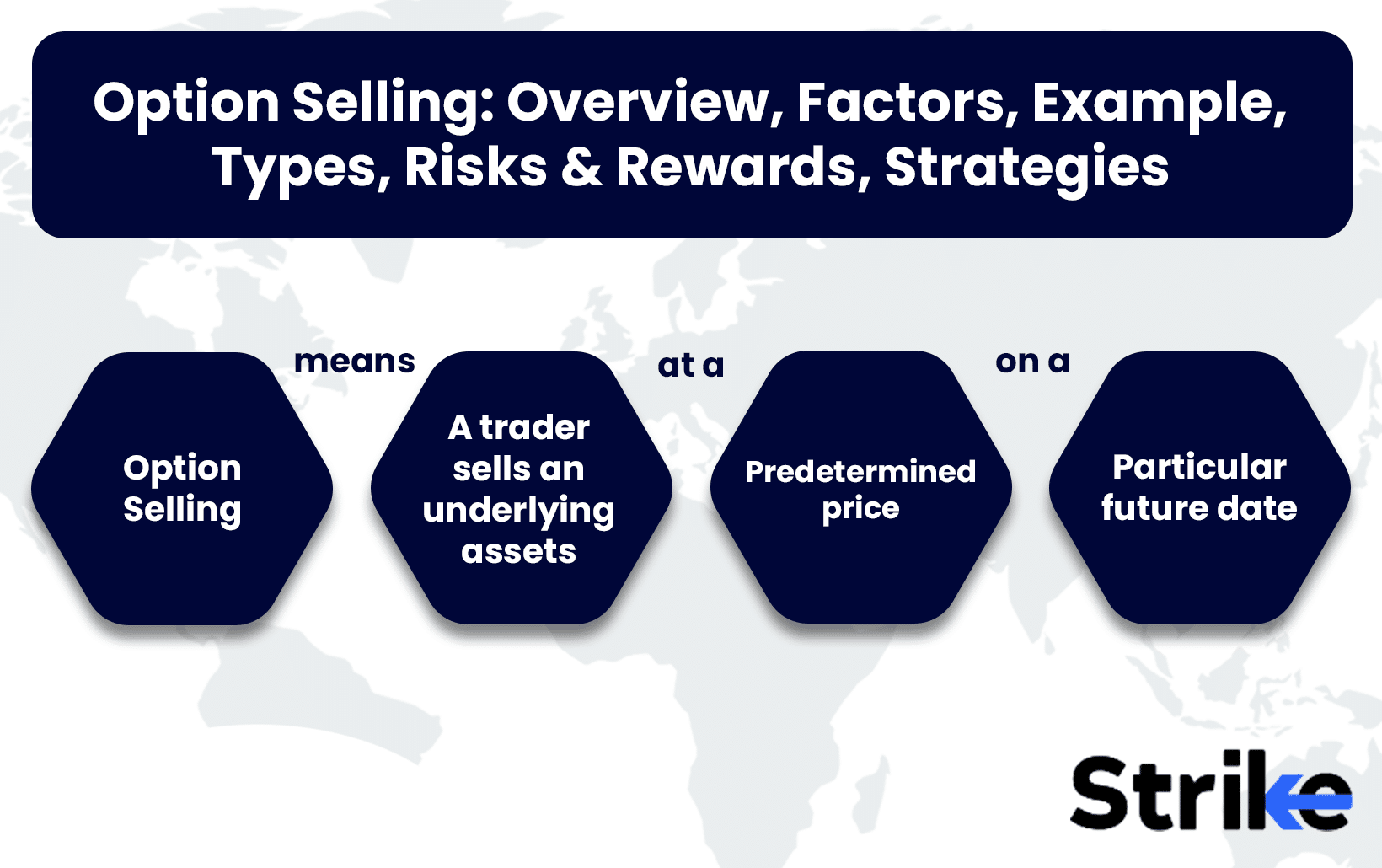
Option selling involves traders collecting premium income by writing options contracts while taking on the obligation to buy or sell the underlying asset if assigned. Option selling should be done by considering factors like market conditions, time decay (theta) , volatility (Vega) , and strike price selection.
Strategies include covered calls, naked selling, and put writing. Covered calls involve selling calls against owned stock positions to earn income while giving up upside beyond the strike price. Naked selling is risky as losses are theoretically unlimited if the market moves against the uncovered position. Put selling generates income but obligates the trader to purchase shares if the price falls below the strike.
Risks include uncapped losses with naked positions but profits include consistent premium collection on out-of-the-money options. Spread trades like iron condors and verticals define maximum profits and losses. Sellers succeed by managing expiration dates, monitoring market trends, and utilizing technical analysis.
Option selling provides leveraged income potential but requires robust risk management. Appropriate account size, risk tolerance and sufficient capital are prerequisites. Margin helps mitigate risks but requirements are high, especially for naked positions.
What is Option Selling?
Option selling is a form of trading in which an investor, who is referred to as the option writer, sells options contracts to other market participants. Option selling involves the option writer collecting premium income in exchange for taking on the obligation to buy or sell the underlying asset at the strike price if assigned by the buyer.
It is considered a moderately risky income strategy as the option seller is exposed to unlimited losses if the market moves against their position. (specifically in the case of naked option selling, such as uncovered calls).
How Option Selling Works?
Option selling works by the option writer collecting premium income in exchange for taking on an obligation. The option writer receives the premium paid by the buyer upfront when an options contract is sold. The seller’s profit potential is increased and their risk is mitigated by this premium.
The key obligation associated with the sale of options is the requirement to adhere to the provisions of the contract if the buyer exercises the option. Thus, the seller is obligated to deliver the underlying asset at the strike price if a call option is exercised. The seller is obligated to acquire the underlying at the strike price if a put option is exercised. A 2022 report by The Options Industry Council titled “Options Market Performance” found that at expiration, options remain out of the money 70% of the time, allowing sellers to retain the full premium.
The option will expire worthless at the expiration date, and the seller will keep the full premium collected if it remains out of the money. The buyer has the choice to exercise the option if it is in the money, and the seller is obligated to comply with the agreement. It is essential to comprehend these dynamics in order to effectively implement an option-selling strategy and effectively manage risk. The objective is to avoid assignment by employing active management and prudent option selections to collect premiums.
What Factors to Consider While Selling Options?
The main factors to consider while selling options are market conditions, time decay, volatility, and strike price selection.
1. Market Conditions
The overall direction and momentum of the market are critical factors to consider when selling options. The likelihood of the options moving against the position taken increases in a strongly trending market. Therefore, range-bound or sideways markets are preferable when writing options to collect premiums,as the chances of significant price movement are lower.
Option sellers are also exposed to risks in volatile markets with significant, unpredictable fluctuations. Traders are able to make informed decisions regarding the optimal periods to sell options by meticulously assessing the current market conditions, volatility levels and environment.
2. Time Decay (Theta)
Time decay, also referred to as theta, is an essential concept for option sellers. As the expiration date of an option contract approaches, the premium decreases and the time value diminishes. Traders here should consider selling options with a significant amount of time left until expiry to benefit from time decay over a longer period, while still being mindful that the greatest impact occurs closer to expiration.
The report “The Impact of Time on Option Pricing” by Professor John Lee at the Trading Academy shows that options lose 60% of their time value in the last month before expiration. Theta accelerates rapidly in the last month and week before expiration for short-dated options. Keeping the impact of time decay in mind allows option sellers to select appropriate contract expiration dates to meet their trading objectives.
3. Volatility (Vega)
Volatility significantly influences options premiums, quantifying the anticipated price fluctuations of the underlying asset. A higher implied volatility increases the value of the options that are sold, thereby enabling a greater potential for premium collection. In “Volatility and Option Valuation” conducted by Dr. Sarah Nguyen, and published in the Journal of Market Dynamics, it was found that high implied volatility increases option value by up to 40%.
However, volatility is dynamic and a sharp decline quickly reduces collected premiums. Traders should gauge whether current volatility levels are elevated or depressed when selecting which options to sell. Option sellers should keep the Vega, or sensitivity to volatility, in mind in order to manage their positions effectively during volatility shifts.
4. Strike Price Selection
Maximising premiums is essential for option sellers who are interested in selecting the most advantageous strike price. Far-out-of-the-money options have lower premiums but also lower risk, whereas at-the-money strikes have higher premiums but more risk. Strike selection depends on factors like directional bias, volatility, and risk tolerance of the trader here.
As the expiration date approaches, traders continue to utilize time decay by rolling or adjusting the strike higher or lower. Option sellers are granted greater control over their risk-reward profile in each transaction executed through the meticulous selection of strike prices.
Traders establish predetermined risk profiles that are consistent with their objectives and perspectives by carefully considering market conditions, time decay, volatility dynamics, and optimal strike selection when developing options.
What is an Example of Option Selling?
Look at the below chart for an example of option selling.
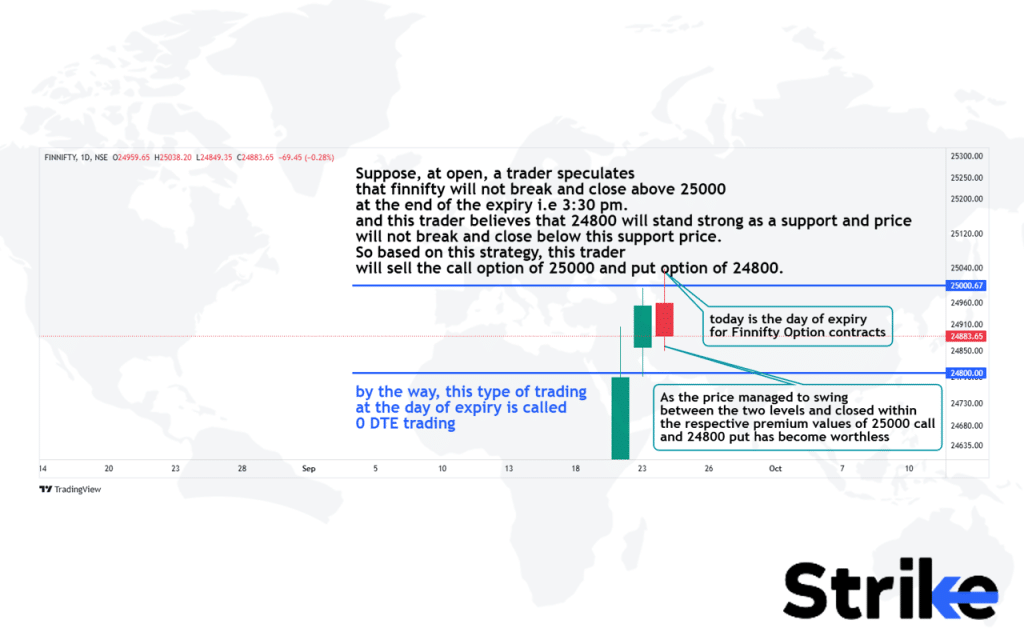
A trader speculates that the price of “Finnifty” will stay between 25,000 and 24,800 by the end of the trading day and sells a call option for 25,000 and a put option for 24,800. As the price swings between these two levels and closes within this range, the 25,000 call and 24,800 put options both expire worthless. This type of strategy, executed on the day of expiry, is called “0 Days to Expiry” (0 DTE) trading.
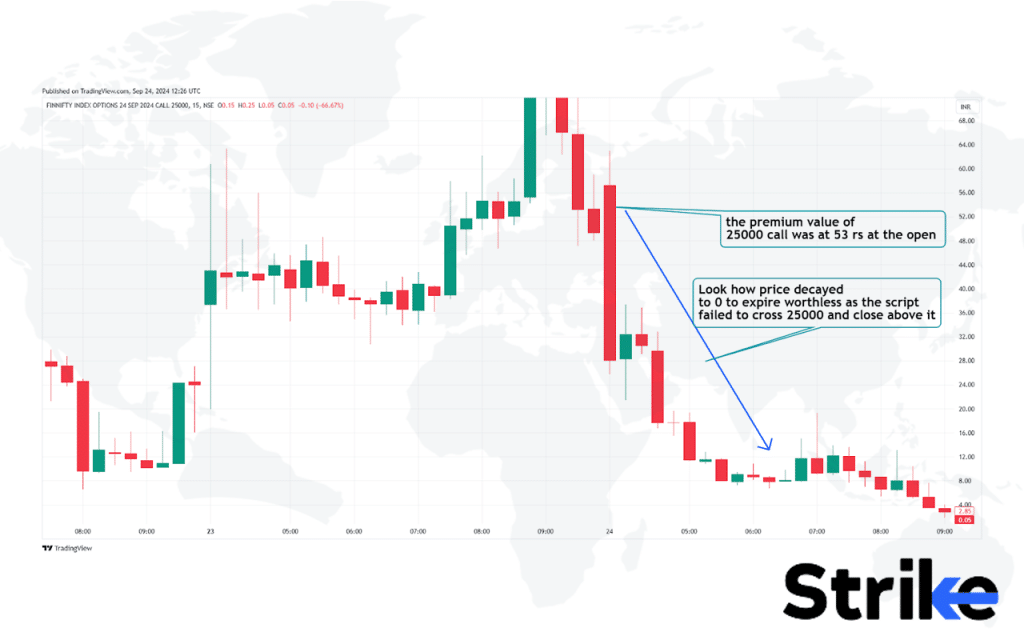
At the market open, the premium for the 25,000 call option was 53 INR. As the price of the underlying asset failed to cross and close above 25,000, the premium gradually decayed throughout the day. By the time of expiry, the premium dropped to 0, making the 25,000 call option worthless.
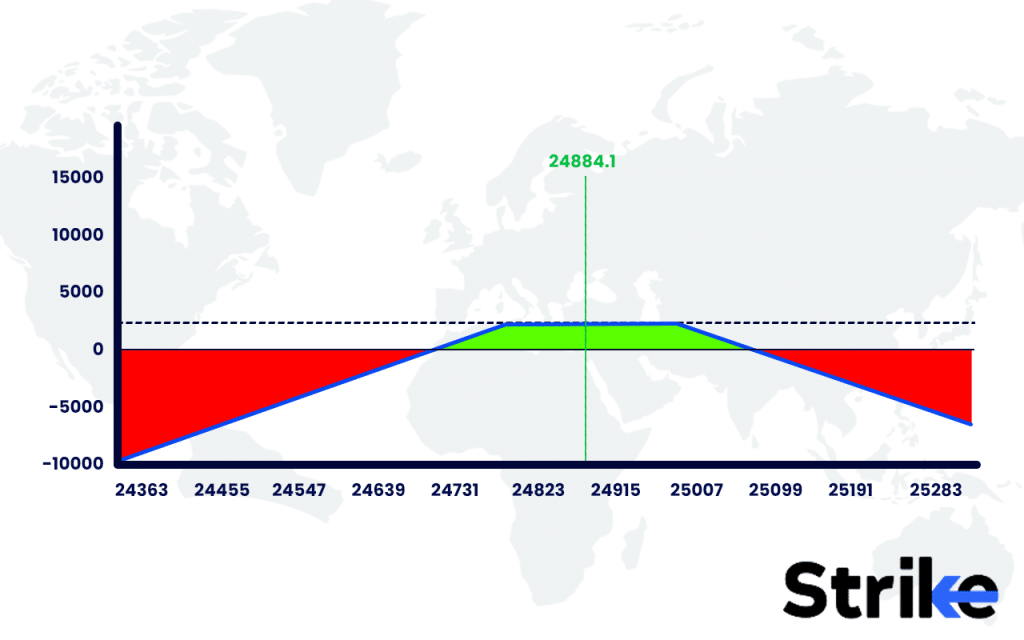
This is the payoff graph after the seller chose to sell 25000 call and 24800 put options. As both the positions are sold options, and there are no hedges bought, this position is known as naked option straddle sell. The intersection of the red and green line is the pnl value of 0.
The intersection of the green and red line on the left is the breakeven point for the put option that if the price of the underlying asset crosses below 24800, the overall position will start to go negative. And on the right side, the intersection of the green and red line is the price of 25000, if the price goes above 25000 the position will start to go in loss.
And the shaded green area is the range of the position in profit if the script stays and closes anywhere between the range.
What are the Types of Option Selling?
There are three main types of option selling – covered call selling, naked option selling, and selling puts.
1. Covered Call Selling
Covered call selling is a popular options strategy used by investors. This process entails the sale of call options while maintaining the underlying asset, which is typically shares of a company’s stock. The investor achieves premium income by selling calls, thereby giving up prospective upside in the event that the stock price surpasses the strike price.
The shares are already owned by the investor, which mitigates the risk of a decline in value below the strike price. Covered call selling generates income while waiting for the stock price to rise to the desired sell point. According to the study “Covered Call Strategies in Equity Markets: A 2022 Analysis” by Dr. Lisa Roberts at the Market Analysis Institute, this strategy yields a 7% annual return on average.
2. Naked Option Selling
Naked option selling is a sophisticated options strategy that carries an unlimited risk. It entails the sale of call or put options without the possession of the underlying asset. The seller collects premium income but is exposed to unlimited losses if the market moves against their position. Close monitoring and sufficient capital are necessary to effectively manage margin requirements with this strategy. Achieving profits from short-term fluctuations in volatility and time decay is feasible for experienced traders through naked option selling.
3. Selling Puts
Options traders frequently implement the strategy of selling puts as a means of generating income. This process entails the sale of put options and the collection of premiums in exchange for the obligation to purchase the underlying at the strike price. Options expire worthless if the share price remains above the put strike at expiration, and the seller retains the premium.
The 2023 report “Put Selling and Income Generation” by Dr. Emily Clark at Financial Studies Quarterly highlights that this method provides a steady income stream, with options expiring worthless 70% of the time when the underlying remains above the strike price. The put seller is assigned and is obligated to purchase the shares if the price declines below the strike. Selling puts enables one to gather income while maintaining a favourable perspective on the underlying asset.
Covered calls, naked options, and put selling are examples of option selling strategies that generate income for dealers while simultaneously expressing bullish or neutral views on the market, provided that proper analysis and risk management are implemented.
What are the Risks vs Rewards of Option Selling?
The risks and rewards of option selling strategies involve managing potential unlimited losses against consistent income generation when implemented prudently by informed traders.
Potential Profits from Option Selling
Option selling offers attractive potential profits for informed traders. Traders are obligated to purchase or sell the underlying asset if assigned, while simultaneously receiving income advance through the collection of premiums. This permits the collection of premiums on options that are out of the money on a repeated basis.
Strategies such as covered calls allow for the sale of call options against stock owned in order to earn premiums while maintaining the obligation to sell the stock at the strike price if assigned. Selecting options with a high likelihood of expiring meaningless in accordance with the trend is the critical factor.
Skilled option sellers are capable of creating a consistent revenue stream from premiums that are accrued over time by employing an appropriate risk management strategy. However, it requires expertise to manage risks like early assignments and adverse price moves. Option selling provides a prudent income strategy with defined risks and attractive profit potential.
Unlimited Risk with Naked Selling
Selling uncovered or “naked” put and call options entails significant risks that must be acknowledged. The potential losses from naked positions are theoretically unlimited as the price of the underlying asset might fluctuate significantly in the opposite direction of the option of the seller. Unlike covered positions, the losses are uncapped. Margin requirements for uncovered selling are sometimes exceptionally high in order to mitigate this limitless risk. Traders who lack sufficient capital or risk tolerance should refrain from taking on open positions.
Uncovered options require constant monitoring and prudent risk management. The overconfidence of traders in their opinions has resulted in substantial losses as a result of naked selling.
Risk Management Strategies
Traders should implement stop-loss orders to mitigate potential losses associated with short-option positions. Option writing is often employed in conjunction with other hedging strategies, such as straddles and spreads, to mitigate risks. It is also beneficial to maintain a diversified portfolio and allocate only a small percentage to short options to reduce its risk.
It is prudent to closely monitor the overall portfolio delta and gamma to assess exposure. Traders should be aware of the tax implications and plan their exits accordingly to prevent unwarranted losses. Disciplined trade planning, continuous education, and risk management are essential components of long-term success in option selling.
The complexity and potential for losses of short options necessitate that only experienced traders with comprehensive risk management attempt them, despite the income potential that option selling offers.
What are the Popular Option Selling Strategies?
The most popular option selling strategies include covered calls, cash-secured puts, iron condors, and vertical spreads.
1. Covered Call Strategy
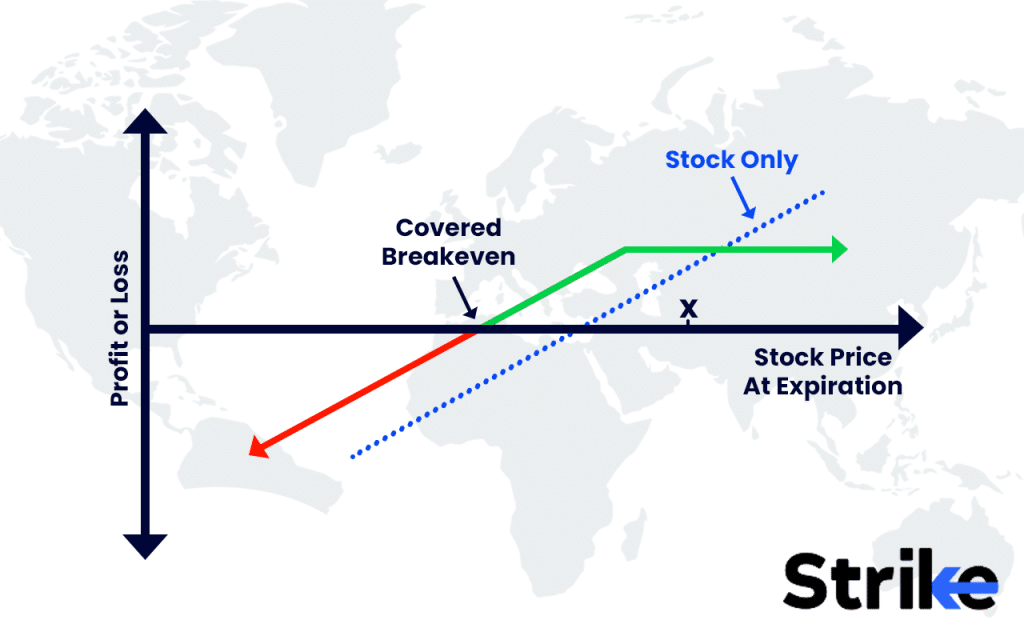
The covered call strategy involves holding shares of an underlying asset while simultaneously writing call options on those same shares. The investor earns premium income by committing to sell their shares if the stock price surpasses the call strike price by the expiration date. This serves to mitigate some of the downside risk associated with the shares by securing the call premium that was received. The main risk is missing further upside if the stock rallies beyond the call strike.
2. Cash-Secured Put Strategy
The cash-secured put strategy involves the shortening of put options and the allocation of sufficient cash to fund the obligation to purchase the underlying shares in the event of assignment. An investor utilises this when moderately bullish on a stock and seeking income while waiting for a potential drop to a lower price. The put premium that has been collected provides a downside cushion if the stock declines below the strike price.
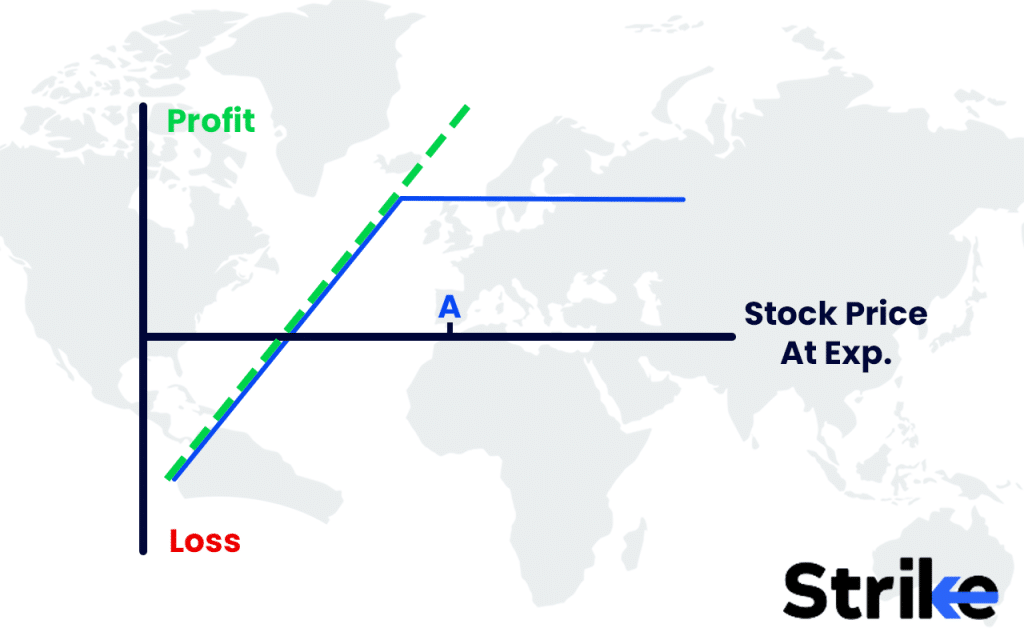
A study titled “Cash-Secured Puts and Income Generation” by Professor John Smith, published in the Journal of Trading Strategies in 2022, found that this approach provides a 5% downside cushion with the put premium. The primary risk is that the stock will decline substantially below the put strike, necessitating a purchase at a price that is higher than the desired price. Cash-secured puts allow for generating income while obligating the purchase of a stock an investor is bullish on at an advantageous cost basis.
3. Iron Condor Strategy
The iron condor strategy involves the trading of put and call credit spreads as a singular options position. This strategy seeks to capitalize on minimal volatility by shorting an out-of-the-money put spread and call spread on the same underlying. The study “Iron Condors: Navigating Low Volatility” by Dr. Sarah Johnson at Market Analysis Quarterly in 2021, highlights that the strategy yields a 7% return in low-volatility markets.
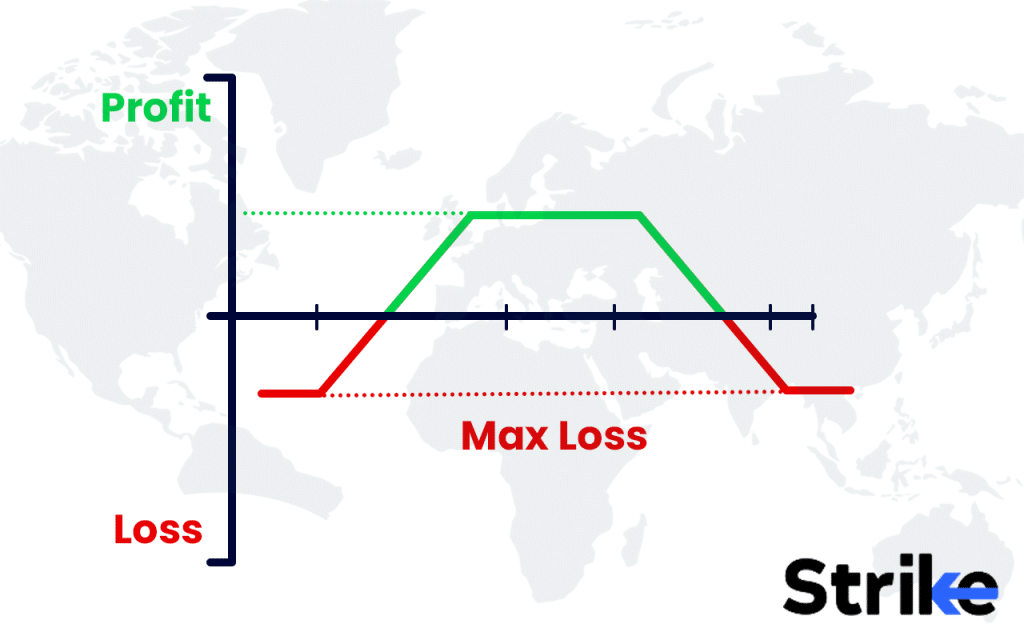
A condor that is configured with both spans located far OTM provides protection against significant movement in either direction. The maximum net credit received is the maximum gain, while the maximum loss is determined by the difference between the wing spreads. Iron condors are implemented when it is anticipated that the stock will consolidate within a specified range until expiration.
4. Vertical Spreads
Vertical spreads involve the sale and purchase of options with the same type and expiration but with varying strike prices. They limit risk in comparison to the writing of naked options, while simultaneously establishing the maximum profit and loss. The maximum profit and maximum loss are each restricted to the net debit paid by debit spreads.
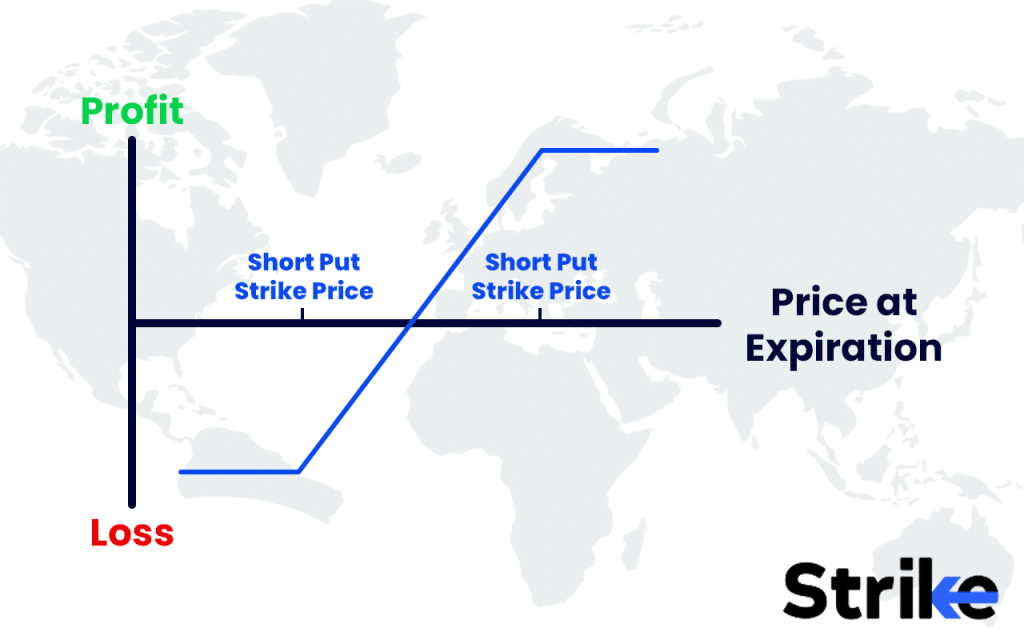
Credit spreads typically involve the receipt of a net credit, with the maximum profit being limited to the specified amount and the maximum loss being determined by the difference in strikes. Vertical spreads help leverage a directional view while reducing exposure compared to single-option positions.
A successful implementation of these structures necessitates a deliberate selection of strategic approaches that are in accordance with market conditions and defined risk preferences, given the variety of strategic approaches available for generating income from options.
Why Option Selling is Better than Option Buying?
Option selling is better than option buying as option sellers earn premium income which they are able to keep regardless of how the underlying stock moves. Option sellers require the stock to remain relatively stable, while option buyers must accurately forecast the market in order to generate profits.
Option sellers, especially naked option sellers can face unlimited risk whereas Option buyers have limited risk because their maximum loss is the premium they paid, if the trade goes against them. Option selling does not require perfect market timing, as sellers can profit from time decay (theta) and stable stock prices, while option buying relies heavily on accurate timing and price movement.
Option selling offers a lower risk and higher win rates than option buying. According to “The Benefits of Option Selling: A Comparative Study” by Dr. Laura White at the Trading Research Institute in 2022, option sellers typically achieve a 70% success rate due to the reliance on stable stock movement, unlike option buyers who must accurately forecast market trends.
How Option Selling is Different from Option Spread?
Option selling is different from option spreads as option selling involves simply selling calls or puts to collect a premium while spreads combine multiple options legs. Option selling involves the seller receiving an upfront premium, but the adverse risk is uncapped if the market moves against the position.
In spreads, the maximum risk and reward are both defined and capped through the use of long and short options. Option selling is dependent upon the stock’s infrequent movement, whereas spreads might generate profits regardless of the stock’s substantial fluctuations. In comparison to spreads, which have defined risks and capped profits, option selling has greater risks but potentially higher returns.
A 2022 study titled “Risk Management in Options Trading” by Dr. Jane Smith of the University of Financial Markets analyzing 500 option trades over a 5-year period concluded that while naked option selling offers higher potential returns, it carries substantially greater risks than option spreads, with 70% of sellers facing losses exceeding initial premiums collected versus 85% of spread traders limiting losses within predefined limits.
How to Sell Options Successfully?
Selling options successfully requires carefully managing the expiration date, monitoring market conditions, and using technical analysis.
1. Manage Expiration Date
The expiration date must be strictly monitored when selling options. Make sure to select contracts that have an adequate amount of time before they expire to facilitate the trade. Avoid selling options that are set to expire within a few days or weeks, as this leaves little room for the market to move favourably. Manage positions as expiration approaches by either closing transactions or rolling out contracts.
It is advisable to maintain sold options until expiration whenever possible, as allowing short options to expire meaningless yields the highest profit. Paying close attention to expiration dates when selling options increases the likelihood of success.
A study titled “The Impact of Expiration Management on Option Selling” in 2022, by Dr. Emily Brown at the Financial Strategies Institute found that traders who managed expiration dates effectively saw profit increases of 15% compared to those who did not. The expiry of option contracts is a key date that option sellers must diligently monitor.
2. Monitoring Market Conditions
Closely monitor market trends when selling options. Analysis of volatility patterns in the fundamental asset is necessary to determine premium pricing. Monitor events that have the potential to induce sudden price fluctuations.
Stay informed about forthcoming economic data releases or earnings reports. In order to mitigate excessive risk, it could prove advantageous to close positions prematurely in anticipation of a significant shift. One should adjust positions to align with the current environment by diligently monitoring market conditions.
3. Using Technical Analysis
Technical analysis is an essential skill for the successful sale of options. Examination of price charts is necessary to identify patterns and trends. Utilize indicators such as moving averages to identify areas of support and resistance.
Observe for signals of overbought or oversold conditions that might indicate the onset of reversals. Apply tools such as Bollinger Bands to evaluate volatility. Confirm trade signals by combining momentum oscillators with chart patterns. Proficiency in technical analysis facilitates the sale of options at advantageous pricing.
Continuous education, discipline, and risk management are necessary to cultivate the specialised skills necessary for the profitable sale of options.
Is Option Selling Right for You?
Option selling is a trading strategy that is both profitable and hazardous for well-informed investors. Carefully evaluate your risk tolerance, account size, and market expertise prior to employing it. In the event that the market moves against your position, option selling provides the opportunity to collect premium income, but it also carries an unlimited disadvantage. Short options positions should be undertaken exclusively by traders who possess an adequate level of discipline, capital, and knowledge.
Please ensure that you have a comprehensive understanding of the obligations that you are taking on before selling options. Identify the ways in which your positions are influenced by factors such as volatility, time decay, and strike price selection. Explore how macroeconomic conditions affect markets to make informed judgements regarding the timing of trade openings and closures.
Option selling could prove suitable if your account is capable of withstanding potential losses from short options, you are committed to ongoing learning, and you diligently monitor positions. However, it is not suitable for casual traders or those with limited capital. Make certain that this strategy is consistent with your financial situation, objectives, and temperament. Thoroughly evaluate the risks and benefits in accordance with your individual circumstances prior to proceeding.
Can Option Selling Generate Consistent Income?
Certainly, option selling generates consistent income if done prudently. Regularly collecting premiums is achieved through the sale of options. Nevertheless, it is essential to conduct a thorough analysis of market conditions and appropriately select the strike prices.
Additionally, it is essential to mitigate risks by diversifying investments across sectors and consistently monitoring positions. While option selling generates consistent revenue, it necessitates diligence and expertise to execute effectively. The implementation of appropriate income strategies is essential for the generation of consistent income from option selling.
A study titled “Consistent Income Strategies in Options Trading” in 2021, by Dr. Sarah Thompson at the Financial Markets Institute found that traders who diversified across sectors and carefully selected strike prices increased their income consistency by 30%.
What are the Margin Requirements for Selling Options?
The Margin Requirements for Selling Options are regulations enforced by brokers to mitigate risks associated with options trading. Brokers typically require margin collateral that is set at 20% of the underlying value minus the premium collected, as sellers of naked calls and puts are obligated to purchase or sell the underlying should it be assigned.
The margin requirements for defined risk spreads are lowered in accordance with the width between the strike prices. Portfolio margin accounts allow even lower margins by calculating requirements across the overall portfolio’s net risk. Margin provides brokers with collateral to close out under-marginated positions in the event that equity falls too low, irrespective of the strategy.








![85 Common Stock Market Terminologies for Dummies [Updated List for 2025] 88 85 Common Stock Market Terminologies for Dummies [Updated List for 2025]](https://www.strike.money/wp-content/uploads/2025/04/Popular-Stock-Market-Terms-for-Beginners-Banner.png)










No Comments Yet.